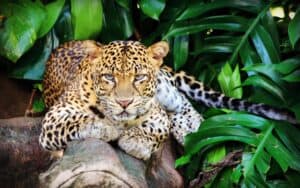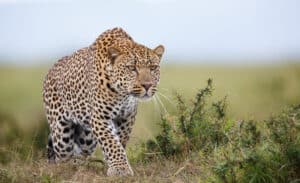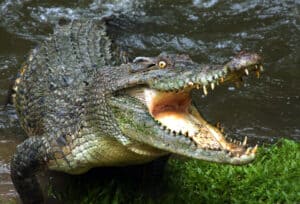The leopard is one of the most distinguished members of the genus Panthera. Scientifically known as the Panthera pardus, it is native to sub-Saharan Africa and southern Asia. There are 7 known species of leopard, and they typically live in mountainous regions, tropical rainforests, and grasslands.
There are myriads of other mesmerizing facts about the leopard, and this article lists 10 of them. Let’s get into it!
1. Leopards Are Strong, Skilled Climbers

Leopards are very adept climbers, and they enjoy resting high up in the trees during the day.
©iStock.com/lightstock
Ever seen a movie where someone was out in the woods trying to escape an animal’s claws and ran up a tree because the animal couldn’t climb? Yeah, well, that would go down well with a lot of animals but not leopards.
Leopards are very adept climbers, and they enjoy resting high up in the trees during the day. Thanks to their incredible strength, especially their massive jaw muscles, leopards can drag carcasses up a tree, even those weightier than them. They mostly do this so as to not lose their kills to hyenas.
2. Leopards Have Immense Adaptability
Leopards prefer rocky landscapes with deep, riverine forests, but they are known to adapt to many regions, including warm and cold climates. They can be found across Africa, the Caucasus region, and Asia. In what was an unlikely discovery, some leopards were found living in Anatolia, Turkey, in the early 1970s. That pretty much explains why they are often called the most widely distributed African big cats.
3. Leopards Make A Variety Of Sounds
Like most other big cats, leopards can roar, although they don’t do it as well or as much as lions. In most cases, their go-to sound is a hoarse bark. They can also purr, alongside myriads of other sounds, including snarls and growls. They even make meow sounds sometimes, and why not? After all, they are still cats.
Some scientists have observed that leopards roar to establish territory, growl when furious, and purr when they are giddy and relaxed.
4. “Leopard” Literally Means “Spotted Lion.”
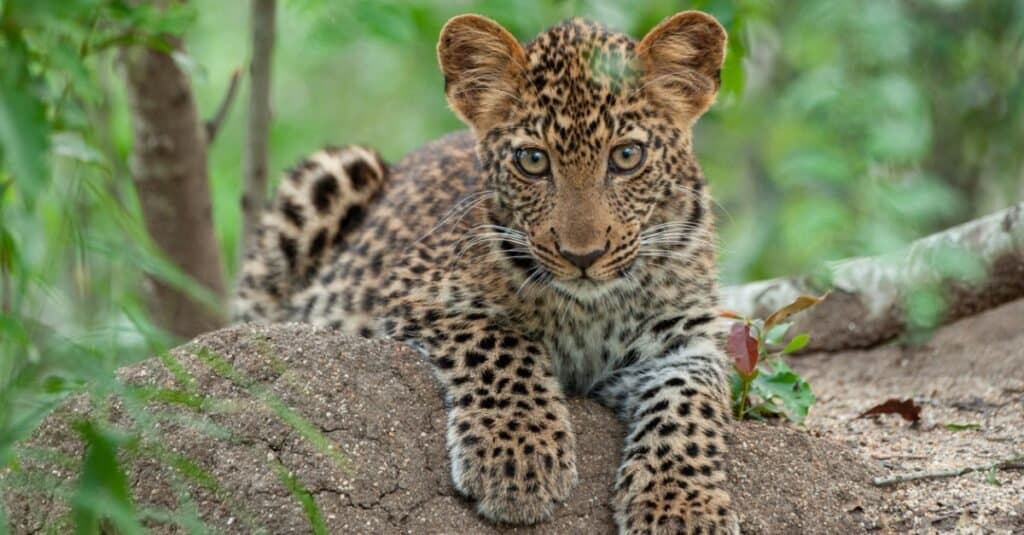
The English word “leopard” is derived from two Greek words – Leon and pardos.
©iStock.com/RudiHulshof
Ever wondered where leopards got their name from? Well, the name itself is derived from two Greek words – “Leon,” which means lion, and “pardos,” which means spotted. There you go! That’s how the English word “leopard” came into being. The Greeks were onto something when they came up with that name because they actually look like spotted lions if you look well enough.
5. Leopard Cubs Live With Their Mothers For About Two Years
Mother leopards typically give birth to a litter of two to three cubs. After giving birth, they would pause their nomadism for a while until the cubs are big enough to accompany them on hunting expeditions. They also hide the cubs in lairs to keep them safe from hyenas and lions while hunting somewhere not so far away from the lairs.
The cubs stop suckling after three months, and they usually down their first piece of meat 7-8 weeks after birth. They then continue to hang around their mothers for about two years before setting out on their own.
6. Leopard Cubs Are Born Blind
Another reason why cubs rely so much on their mothers is that they are usually blind for the first 10 days of their lives. After 10 days, their eyes begin to open, and they remain extraordinarily blue for the first few months. Owing to this unavoidable vulnerability, mother leopards devised lairs where they keep their cubs while they scour for food.
Mother leopards are definitely among the best nurturers in the wild. Isn’t that lovely?
7. Leopards Are Nocturnal Animals

Leopards spend a portion of their day sleeping, while they go hunting after dusk.
©iStock.com/UrmasPhotoCom
Considering the fact that they are native to sub-Saharan Africa, it would be odd for leopards not to be nocturnal. They spend a portion of their day sleeping and accumulating energy, while they go hunting after dusk, when the temperature is generally cooler. They also spend the day lounging in trees or hiding in caves away from the sun’s scourge.
In addition, their activity at night is bolstered by their natural ability to see seven times better than humans in the dark, thanks to their excellent retinas.
8. There Are Black Leopards
Did you know that there are black leopards? Well, there are, and they are commonly called black panthers. Thanks to the Marvel Cinematic Universe, everyone is familiar with the black panther, a.k.a the black leopard. Contrary to what you may have thought, the black color doesn’t make them a different subspecies, but it is a consequence of excess melanin.
In Africa, black panthers have been spotted only a few times, which is an indication of their extreme rarity.
9. Leopards Like To Catch Their Prey Unaware
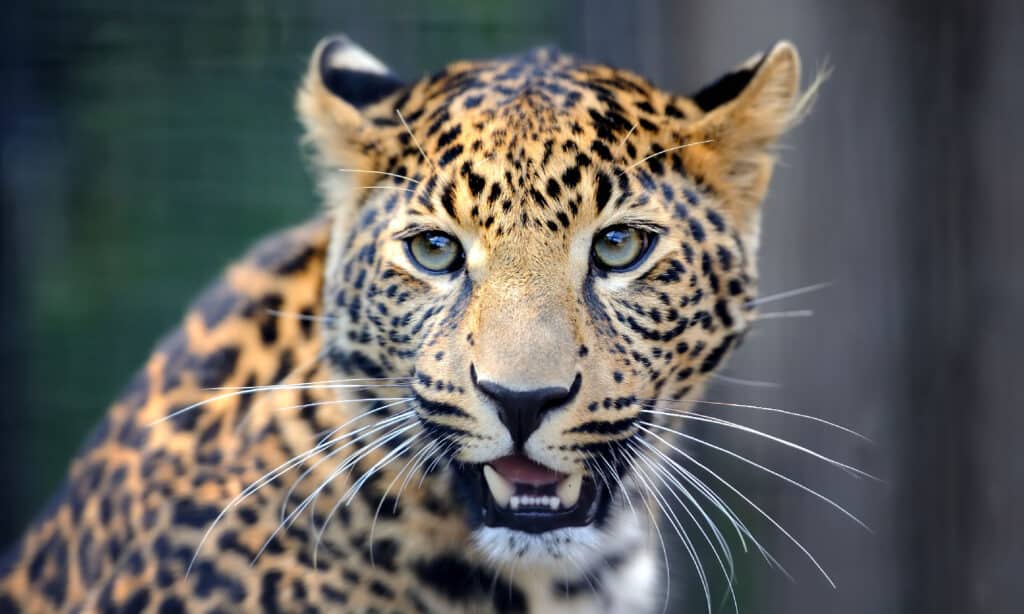
Leopards are very skilled hunters.
©iStock.com/Byrdyak
Leopards are very skilled hunters, and their skin and fur make it easy for them to camouflage in the wild. Once they have their eyes on a possible prey, leopards would keep their heads and legs bent while walking slowly, quietly, and unsuspectingly until the prey is within 5-10 meters from them. Then, they emerge suddenly, aim for the prey’s neck, and pounce. Voila! Pretty sleek, right?
10. Leopards Are Super-Fast
One of the most incredible characteristics of leopards is their speed. They are known to clock speeds of between 35 and 37 miles per hour, which is insanely fast. While they are not as fast as cheetahs and lions, they can certainly hold their own with regard to speed.
Besides their speed, leopards are also excellent leapers, and they can jump up to 20 feet horizontally and 10 feet vertically.
Bonus Facts About Leopards
- Adult leopards are solitary animals, and they only spend time with other leopards when they want to mate. To mark their territory and ward off other leopards, they would leave scratches on trees as well as urine scent marks.
- Leopards are listed as vulnerable on the IUCN Red List, owing to their declining population globally. Major threats are trophy hunting by locals and habitat loss.
The photo featured at the top of this post is © lightstock/Shutterstock.com
Thank you for reading! Have some feedback for us? Contact the AZ Animals editorial team.



